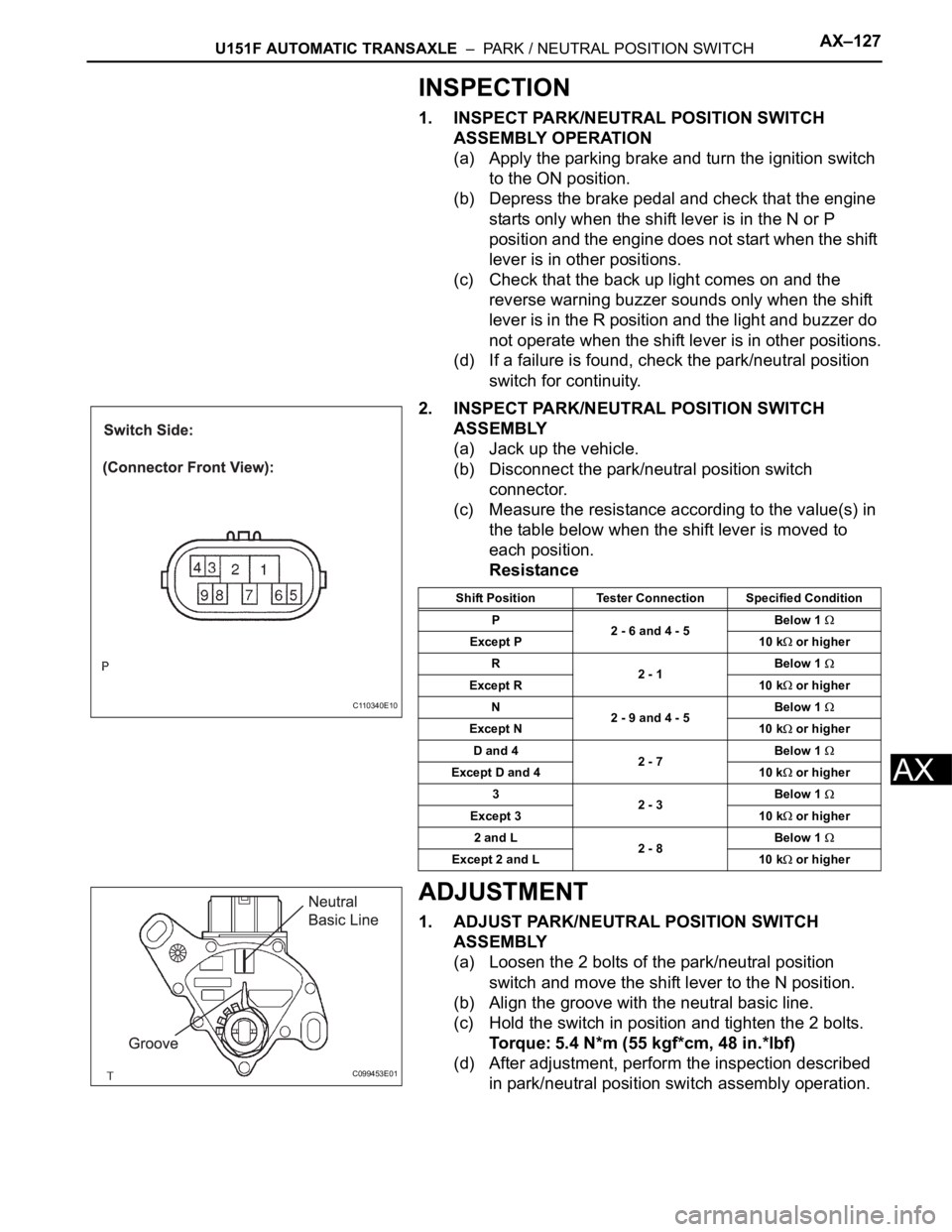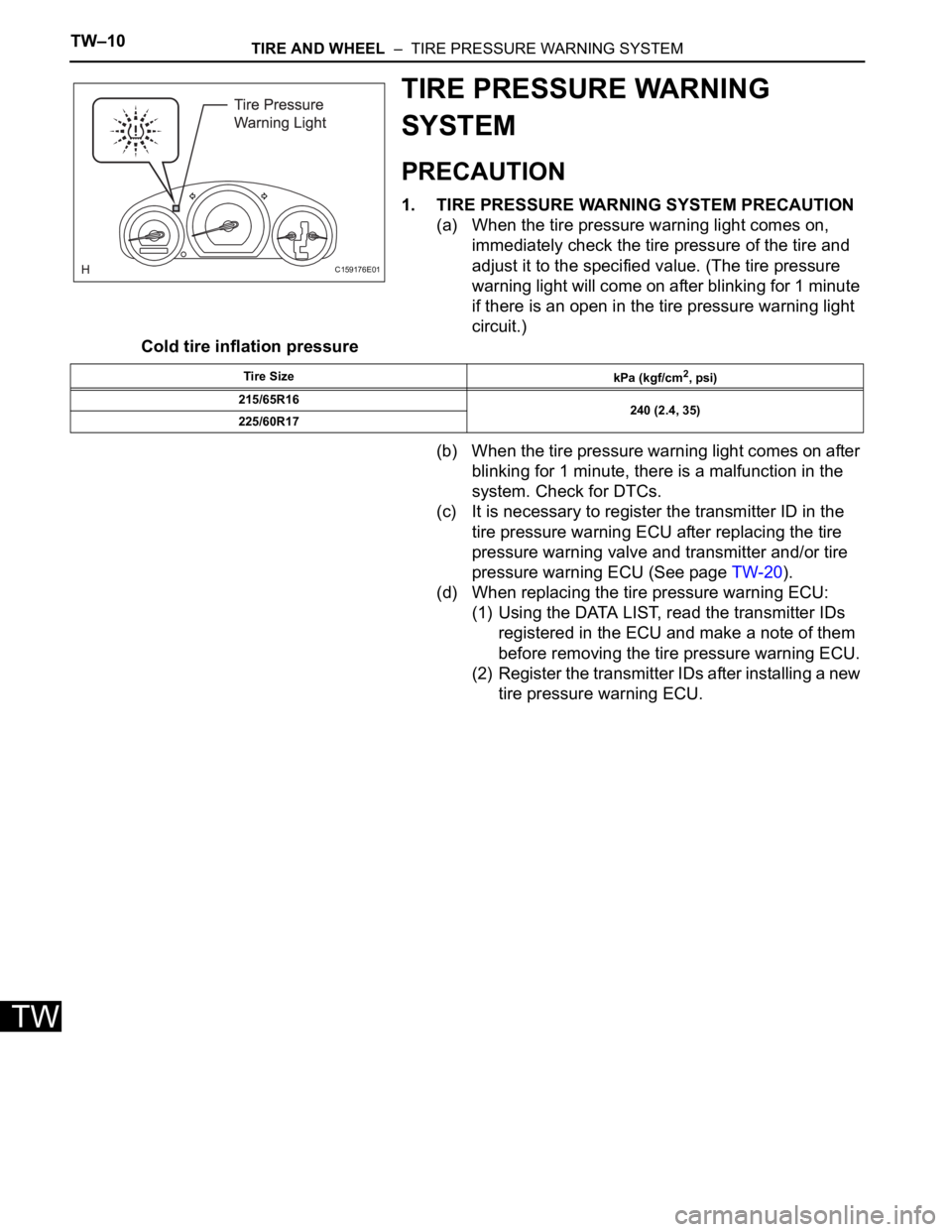2007 TOYOTA SIENNA warning light
[x] Cancel search: warning lightPage 1810 of 3000

U151F AUTOMATIC TRANSAXLE – PARK / NEUTRAL POSITION SWITCHAX–127
AX
INSPECTION
1. INSPECT PARK/NEUTRAL POSITION SWITCH
ASSEMBLY OPERATION
(a) Apply the parking brake and turn the ignition switch
to the ON position.
(b) Depress the brake pedal and check that the engine
starts only when the shift lever is in the N or P
position and the engine does not start when the shift
lever is in other positions.
(c) Check that the back up light comes on and the
reverse warning buzzer sounds only when the shift
lever is in the R position and the light and buzzer do
not operate when the shift lever is in other positions.
(d) If a failure is found, check the park/neutral position
switch for continuity.
2. INSPECT PARK/NEUTRAL POSITION SWITCH
ASSEMBLY
(a) Jack up the vehicle.
(b) Disconnect the park/neutral position switch
connector.
(c) Measure the resistance according to the value(s) in
the table below when the shift lever is moved to
each position.
Resistance
ADJUSTMENT
1. ADJUST PARK/NEUTRAL POSITION SWITCH
ASSEMBLY
(a) Loosen the 2 bolts of the park/neutral position
switch and move the shift lever to the N position.
(b) Align the groove with the neutral basic line.
(c) Hold the switch in position and tighten the 2 bolts.
Torque: 5.4 N*m (55 kgf*cm, 48 in.*lbf)
(d) After adjustment, perform the inspection described
in park/neutral position switch assembly operation.
C110340E10
Shift Position Tester Connection Specified Condition
P
2 - 6 and 4 - 5Below 1
Except P 10 k or higher
R
2 - 1Below 1
Except R 10 k or higher
N
2 - 9 and 4 - 5Below 1
Except N 10 k or higher
D and 4
2 - 7Below 1
Except D and 4 10 k or higher
3
2 - 3Below 1
Except 3 10 k or higher
2 and L
2 - 8Below 1
Except 2 and L 10 k or higher
C099453E01
Page 2251 of 3000

TW–16TIRE AND WHEEL – TIRE PRESSURE WARNING SYSTEM
TW
SYSTEM DESCRIPTION
1. DESCRIPTION OF SYSTEM
(a) A tire pressure warning valve and transmitter is
equipped with a tire pressure sensor and a
transmitter and is installed in a tire wheel assembly.
The sensor measures the tire pressure. The
measured value and transmitter ID are transmitted
to the tire pressure warning antenna and receiver on
the body as radio waves and then sent to the tire
pressure warning ECU from the tire pressure
warning antenna and receiver. If the transmitter ID
has already been registered, the ECU compares the
measured air pressure value with the specified
value. When the value is less than the specified
value registered in the tire pressure warning ECU,
the warning light on the combination meter comes
on.
• The tire pressure warning reset switch addresses
the differences in the standard pressure of the
tire.
2. INITIAL CHECK
(a) The tire pressure warning light turns on for 3
seconds after the ignition switch ON and then goes
off.
HINT:
If the warning light does not turn on for 3 seconds,
troubleshoot the tire pressure warning light circuit.
C159181E01
C124985E04
Trouble Area See procedure
Tire pressure warning light circuitTW-74
Page 2252 of 3000

TIRE AND WHEEL – TIRE PRESSURE WARNING SYSTEMTW–17
TW
3. WHEN TIRE PRESSURE WARNING LIGHT IS LIT
(a) When the tire pressure warning light does not go off,
or when it comes on during driving, check tire
pressure. If the tire pressure warning light comes on
within several hours after adjusting the tire
pressure, the tire may have a slow air leak.
(b) Under the following conditions, the system may not
function properly.
• Facilities or devices that use similar radio
frequencies are located in the vicinity of the
vehicle.
• A radio device of similar frequency is used in the
vehicle.
• A large amount of snow or ice is stuck to the
vehicle, especially onto the wheels and around
the wheel houses.
• The ID of the tire pressure warning valve and
transmitter has not been registered with the
ECU.
• A film or window tint that may interfere with radio
waves is attached on the glass.
• The battery of the sensor has been depleted.
• The tires without tire pressure warning valve and
transmitter are used.
• Tire chains are used.
• The use of non-genuine wheels may result in the
system failure or air-leak.
• Depending on the tire type, the system may not
function properly even though the specified
wheels are used.
(c) After removing and installing the ECU or a sensor,
check for a diagnostic trouble code and verify that it
is a normal code.
4. FUNCTION OF COMPONENTS
5. TIRE PRESSURE WARNING RESET SWITCH
• By operating the tire pressure warning reset switch,
the tire pressure warning ECU can be set to issue a
warning at an inflation pressure that corresponds to
the standard pressure of tires.
Therefore, the dealer must set the warning threshold
to the proper value in order to comply with the local
regulations.
Components Function
Tire pressure warning valve and transmitterCombined as a single unit with a disc wheel air valve, it measures tire pressure and
temperature and transmits an ID number for measurement value and identification.
Built-in the battery.
Tire pressure warning antenna and receiverReceives and transmits a necessary signal from the transmitter to the tire pressure
warning ECU.
Tire pressure warning ECUReceives a signal from the receiver and identifies it as vehicle's own signal. If the
measured value is equal to or lower than the specified value, it transmits a signal so
that the tire pressure warning light on the combination meter comes on.
Tire pressure warning lightLocated in the combination meter, it informs the driver of lowered tire air pressure
and system failure.
Tire pressure warning reset switch Enters the initialization mode for the change of the standard pressure
Page 2253 of 3000

TW–18TIRE AND WHEEL – TIRE PRESSURE WARNING SYSTEM
TW
• Operate the tire pressure warning reset switch only
after the inflation pressures of all tires have been
adjusted on the vehicle.
• To initialize the system, press and hold the tire
pressure warning reset switch for 3 seconds or longer
with the ignition switch ON. After the initialization
process has started, the warning light blinks 3 times
(1 second on, 1 second off).
• During initialization, the tire pressure warning valve
and transmitter measures the inflation pressure of the
tires, and registers the signals that are transmitted
into the tire pressure warning ECU at a frequency of
once per 3 minutes. The initialization process is
completed when signals from all the tires have been
received. It takes several minutes.
Page 2256 of 3000

TIRE AND WHEEL – TIRE AND WHEEL SYSTEMTW–5
TW
REPAIR
1. INTRODUCTION
(a) This section introduces ways to determine whether
the run-flat tire is repairable or not. Repair must be
performed by following the appropriate procedures.
If a flat tire occurs, it is possible to drive a maximum
of 160 km (100 miles) at a speed below 90 km/h (55
mph) due to the reinforced sidewalls. However, if
the customer continues to drive with low tire
pressure (less than about 100 kPa (1.0 kgf/cm
2,
14.5 psi) and tire pressure warning light is on), the
inside of the sidewall will gradually deteriorate and
the run-flat performance may be reduced.
Therefore, the tires may require replacement.
However, there are some cases where it is possible
to repair a run-flat tire using the same repair method
as for normal tires. Use the following flowchart to
determine if a run-flat tire is repairable.
NOTICE:
When performing repairs, follow the Rubber
Manufacturers Association (RMA) repair
procedures.
2. REPAIR PROCEDURE (CUSTOMER INTERVIEW)
(a) The tire pressure warning system can help
determine the history of the tire's use. The driving
conditions the tire was subjected to while the tire
pressure warning light was on should be obtained
from the customer. Also, make sure to ask the
following questions.
(1) Was the vehicle driven at a speed over 90 km/h
(55 mph) with the tire pressure warning light
on?
(2) Was the vehicle driven over 160 km (100 miles)
with the tire pressure warning light on?
A "Yes" response to either of the above will
greatly reduce the chance of tire repairability.
3. TECHNICIAN TIRE INSPECTION
(a) After the customer interview, it is necessary to
conduct a thorough inspection of the tire after it has
been removed from the wheel. As it is difficult to
identify a tire with low pressure visually, check the
pressure of each tire to determine the tire(s) causing
the low-pressure warning. If the tire is found to be
repairable, follow the RMA repair procedures.
NOTICE:
The deflated tire may be extremely hot, which
may cause injury, so allow the tire to cool prior
to handling.
Page 2261 of 3000

TIRE AND WHEEL – TIRE PRESSURE WARNING SYSTEMTW–19
TW
HOW TO PROCEED WITH
TROUBLESHOOTING
HINT:
• Use the following procedures to troubleshoot the tire
pressure warning system.
• *: Use the intelligent tester.
NEXT
(a) Interview the customer to confirm the trouble.
HINT:
It is important to collect as much specific information as
possible from the customer to allow for a quick repair.
NEXT
(a) Adjust all tire pressures to the standard values.
Result
A
B
(a) Check for DTCs (See page TW-34).
Result
B
A
(a) Refer to DIAGNOSTIC TROUBLE CODE CHART (See
page TW-37).
1VEHICLE BROUGHT TO WORKSHOP
2CUSTOMER PROBLEM ANALYSIS
3ADJUST TIRE PRESSURE
Condition Proceed to
Tire pressure warning light goes off A
Tire pressure warning light remains on B
Go to step 9
4CHECK FOR DTC*
Result Proceed to
DTC is output A
DTC is not output B
Go to step 6
5DTC CHART
Page 2264 of 3000

TW–26TIRE AND WHEEL – TIRE PRESSURE WARNING SYSTEM
TW
2. INITIALIZATION PROCEDURE
(a) Make sure that the ignition switch is off.
(b) Connect the intelligent tester to the DLC3.
(c) Turn the ignition switch to the ON position.
(d) Select "TIREPRESS" by following the prompts
displayed on the intelligent tester.
(e) Press the tire pressure warning reset switch within
30 seconds after turning the ignition switch ON.
Keep the tire pressure warning reset switch pressed
for 3 seconds or more with the ignition switch ON.
(f) Check that the tire pressure warning light blinks 3
times (1 second ON, 1 second OFF).
HINT:
Initialization will be completed if signals are received
from all the wheels.
(g) Wait for 5 to 6 minutes with the ignition switch ON.
NOTICE:
• The initialization is normally completed
within 5 to 6 minutes.
• If the initialization has not been completed
successfully, DTC C2177/77 is set after the
vehicle is driven for 20 minutes or more.
• The initialization can be terminated by
connecting terminals TC and CG of the DLC3
connector.
3. CHECK THAT INITIALIZATION HAS BEEN
COMPLETED
(a) Confirm that the data of tire pressure of all tires are
displayed on the intelligent tester screen.
TIRE PRESSURE:
C159182E02
F100115E55
Tester Display Measurement Item/Range Normal Condition Diagnostic Note
TIREPRESS1ID1 tire inflation pressure (Absolute
pressure) /
min.: 100 kPa (1 kgf/cm
2, 14 psi)
max.: 449.35 kPa (4.5 kgf/cm2, 63 psi)Actual tire inflation pressureIf 100 kPa (1 kgf/cm
2, 14 psi) for
absolute pressure is displayed, the
data has not been received.*
TIREPRESS2ID2 tire inflation pressure (Absolute
pressure) /
min.: 100 kPa (1 kgf/cm
2, 14 psi)
max.: 449.35 kPa (4.5 kgf/cm2, 63 psi)Actual tire inflation pressureIf 100 kPa (1 kgf/cm
2, 14 psi) for
absolute pressure is displayed, the
data has not been received.*
Page 2268 of 3000

TW–10TIRE AND WHEEL – TIRE PRESSURE WARNING SYSTEM
TW
TIRE PRESSURE WARNING
SYSTEM
PRECAUTION
1. TIRE PRESSURE WARNING SYSTEM PRECAUTION
(a) When the tire pressure warning light comes on,
immediately check the tire pressure of the tire and
adjust it to the specified value. (The tire pressure
warning light will come on after blinking for 1 minute
if there is an open in the tire pressure warning light
circuit.)
Cold tire inflation pressure
(b) When the tire pressure warning light comes on after
blinking for 1 minute, there is a malfunction in the
system. Check for DTCs.
(c) It is necessary to register the transmitter ID in the
tire pressure warning ECU after replacing the tire
pressure warning valve and transmitter and/or tire
pressure warning ECU (See page TW-20).
(d) When replacing the tire pressure warning ECU:
(1) Using the DATA LIST, read the transmitter IDs
registered in the ECU and make a note of them
before removing the tire pressure warning ECU.
(2) Register the transmitter IDs after installing a new
tire pressure warning ECU.
C159176E01
Tire Size
kPa (kgf/cm2, psi)
215/65R16
240 (2.4, 35)
225/60R17